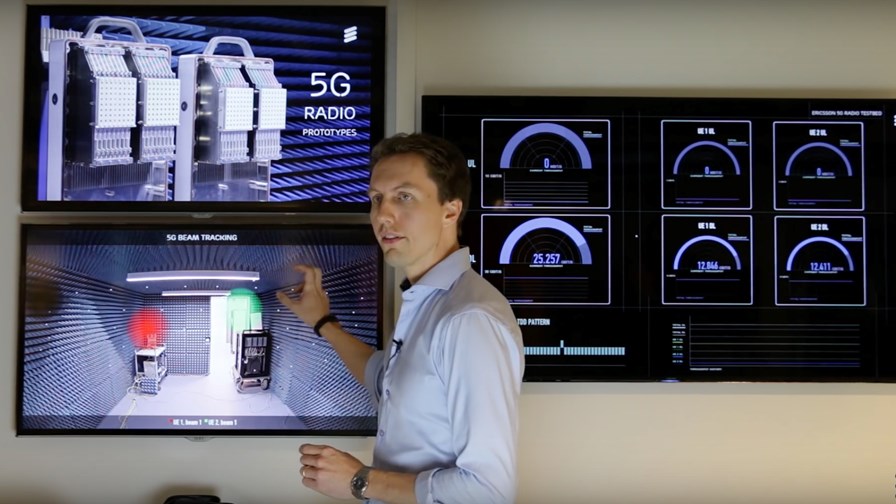
© Ericsson
- Nokia to premiere its 5G-ready network
- Ericsson and King's College London demonstrate 5G tactile robotic surgery
- Sub-6GHz test system from Qualcomm
- TelecomTV on site at 5G World in London, come and see us there
With only a day to go before the 5G World event opens in London (previously the Amsterdam-based LTE World), and the Mobile World Congress Shanghai event begins in China, the major telecoms vendors are keen to showcase their technology leadership capabilities.
4.5GHz radio access demo from Nokia
Nokia has announced that it will make the first ever demonstration of a 5G network running on commercial platforms as part of its showcase at 5G World. Following the launch in February of its 5G-ready AirScale Radio Access technology, Nokia will demonstrate AirScale working together with its Cloud Packet Core, running on a Nokia AirFrame data center platform, which it says is the foundation of a commercial 5G architecture. Its AirScale Radio Access demo will use a 4.5GHz 5G cmWave access system using higher order MIMO antenna technology.
Nokia Bell Labs will also demonstrate a new concept in Network Slicing, which will create and automatically map capabilities for the radio, transport, core and application layers into a discreet network 'slice'. Using cloud orchestration, new services can be created instantly and delivered to meet the specific and diverse demands of any customer or application, such as providing low-latency support to control machines in a factory, or providing extreme high-speed broadband to enterprises and homes.
“By introducing 5G-ready technologies now in our commercial solutions, which support today's LTE-Advanced and the upcoming LTE-Advanced Pro / Pro II, our customers can smartly bridge their networks to 5G,” explained Hossein Moiin, CTO, Mobile Networks, Nokia. “This will allow them to create and capture new business and meet the massive data demand from people and IoT as it develops.”
Remote tactile surgery use case from Ericsson
Ericsson and King's College London will be demonstrating 5G tactile robotic surgery at 5G World. The “Remote Control and Intervention” 5G medical use case will show a probe as a robotic representation of a biological finger that gives the surgeon the sense of touch in minimally invasive surgery, and is able to send accurate real time localization of hard nodules in soft tissue. The probe, or robotic finger, is able to identify cancer tissue and send information back to the surgeon as haptic feedback.
Ericsson wants visitors to experience 5G latency by controlling the movements of the robotic finger with a haptic glove, and once the probe detects the hard tissue in the simulation it will send a haptic signal back to the user device. They will also have visual feedback of what is happening with a close view of the soft tissue model. The demo makes use of SDN, configured to provide the necessary Quality of Service by implementing networking slicing end-to-end.
"Through this 5G simulation demonstration we can show how latency is a critical part of what 5G can deliver, bringing both the sense of touch and an essential real-time video feed to remote surgery,” said Valter D'Avino, Head of Ericsson Western & Central Europe.
"By 5G enabling enhanced minimally invasive remote surgery, the number of applications escalates and the advantages are no longer geographically localized,” added Professor Mischa Dohler, Head of the Centre for Telecommunications Research in the Department of Informatics at King's College London. “It enables worldwide mentorship and scalability of diagnosis and intervention."
Sub-6GHz test system from Qualcomm
Meanwhile in Asia, a prototype system from Qualcomm Technologies is on show at Mobile World Congress Shanghai, in partnership with China Mobile, to help test, demonstrate and trial 5G designs to drive 3GPP 5G New Radio (NR) standardisation. The 5G NR prototype system operates in the sub-6GHz spectrum bands and complements Qualcomm’s existing 5G mmWave prototype system, which operates at 28 GHz.
Designs implemented on the prototype system are being used by Qualcomm to encourage the standardisation of a new, OFDM-based 5G NR air interface. It should be noted, however, that OFDM is only one of five (or six, if you include OFTS by Cohere) proposed air interface waveforms – see TelecomTV’s article on the subject here. There’s still much discussion before 3GPP selects its preferred solution.
The 5G NR prototype system consists of both a base station and user equipment (UE), serving as a testbed for verifying 5G NR capabilities. It supports wide RF bandwidths over 100MHz, capable of delivering multi-gigabit per second data rates. It also supports a new integrated subframe design for lower over-the-air latency than what is possible in today’s 4G LTE network.
“The 5G NR prototype further demonstrates our leadership in developing a unified, more capable 5G air interface, building upon our long-standing expertise in delivering OFDM chips and technology with LTE and Wi-Fi,” said Matt Grob, EVP and CTO, Qualcomm Technologies.
“We are happy to be working with Qualcomm to showcase the sub-6GHz 5G prototype system at Mobile World Congress Shanghai,” said Madam Huang Yuhong, the DGM of China Mobile Research Institute. “This is a great example of the 5G technology collaboration we set out to accomplish when we announced the 5G Joint Innovation Center earlier this year.”
- TelecomTV will be publishing our videos and features from 5G World in the coming weeks. If you are attending the event, please come by our booth (#24) and say hello.
Email Newsletters
Sign up to receive TelecomTV's top news and videos, plus exclusive subscriber-only content direct to your inbox.




